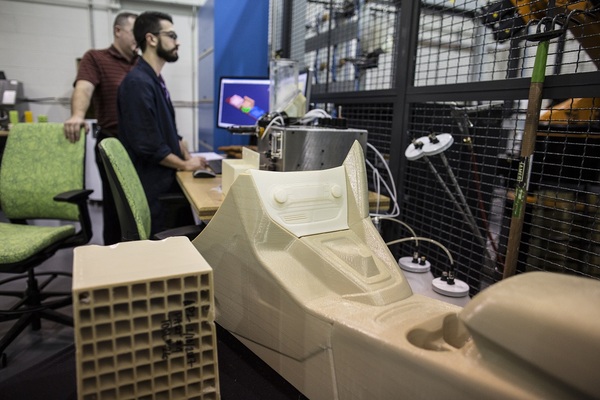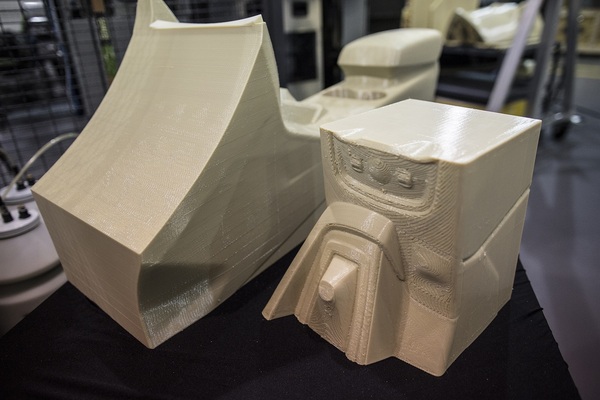
2020-11-25
Automotive first 3D printing technology, the production of large auto partsFord plans to use 3D printing technology Production of large auto parts, to meet customer demand for product lightweight and customized
Ford Motor Company is using Stratasys Infinite Build 3D printer for testing to print large auto parts   Dearborn, Mich., March 8, 2017 - Ford Motor Company, as the first car manufacturer to use the Stratasys Infinite Build 3D printer, is exploring how to use 3D technology to print large integrated automotive components such as cars Baffle plate, and use it for prototype car making and future vehicle manufacturing. The Stratasys Infinite Build system can print virtually any shape or length of auto parts to produce less demanding molds, prototype parts or components in a more cost-effective manner, such as Ford's performance models or custom-made auto parts. The system may become a breakthrough technology in the automotive industry. "With Infinite Build technology, we can now print large molds, fixtures and parts that will allow us to be more flexible in designing iterations.We are pleased to be the first to be the first to be," said Ellen Lee, director of research and technology at Ford's laminated manufacturing. Stratasys' new technology is in use, which helps us drive this large-scale printing technology development for automotive applications and needs. " The new 3D printing system is now located at Ford's research and innovation center in Dearborn, Michigan. A new manufacturing technology With the increased efficiency and cost reduction of 3D printing, many companies are applying this emerging technology to related applications in aerospace, education and medical applications. According to Global Industry Analysts Inc. data, recent advances in technology, emerging applications and government support have contributed to the wider adoption of 3D printing. By 2020, the global market value of the 3D printing market is expected to reach 9.6 billion US dollars. Future 3D printing can bring significant benefits to automotive production, including the production of lighter parts, which may help improve fuel efficiency. For example, the weight of the 3D print chute may not be less than half the metal cast baffle. In addition, 3D printing technology is more cost-effective in the production of smaller parts, such as prototype and racing parts. Ford can also use the technology for customers to print larger size of the mold, fixtures and personalized custom parts. 3D printing technology principles The computer-aided design program transfers the part specifications to the printer's computer for analysis and design. Then, the equipment starts printing, printing a layer of material (in this case plastic), and then gradually stack these materials layer by layer for the finished 3D objects. When the system detects that the raw material or supply material tank is used up, the machine arm will automatically replace it with a full tank. This allows the printer to work continuously for hours or days in unattended conditions. 3D printing advantage Although the speed of 3D printing technology is not fast enough for mass production, it is a more cost-effective way for small-scale parts production, such as prototype and racing parts. Not only that, when the mass production process is not limited, the design and production process of parts is more efficient. If you use the traditional method, the engineer will first create the computer model of the part, waiting for a few months after the prototype mold can be produced. With 3D printing technology, Ford only a few days to print the same parts, the cost greatly reduced. For example, within a few days - not the original months - it would be possible to produce prototypes of new intake manifolds at a lower cost.
Dearborn, Mich., March 8, 2017 - Ford Motor Company, as the first car manufacturer to use the Stratasys Infinite Build 3D printer, is exploring how to use 3D technology to print large integrated automotive components such as cars Baffle plate, and use it for prototype car making and future vehicle manufacturing.
The Stratasys Infinite Build system can print virtually any shape or length of auto parts to produce less demanding molds, prototype parts or components in a more cost-effective manner, such as Ford's performance models or custom-made auto parts. The system may become a breakthrough technology in the automotive industry.
"With Infinite Build technology, we can now print large molds, fixtures and parts that will allow us to be more flexible in designing iterations.We are pleased to be the first to be the first to be," said Ellen Lee, director of research and technology at Ford's laminated manufacturing. Stratasys' new technology is in use, which helps us drive this large-scale printing technology development for automotive applications and needs. "
The new 3D printing system is now located at Ford's research and innovation center in Dearborn, Michigan.
A new manufacturing technology
With the increased efficiency and cost reduction of 3D printing, many companies are applying this emerging technology to related applications in aerospace, education and medical applications. According to Global Industry Analysts Inc. data, recent advances in technology, emerging applications and government support have contributed to the wider adoption of 3D printing. By 2020, the global market value of the 3D printing market is expected to reach 9.6 billion US dollars.
Future 3D printing can bring significant benefits to automotive production, including the production of lighter parts, which may help improve fuel efficiency. For example, the weight of the 3D print chute may not be less than half the metal cast baffle.
In addition, 3D printing technology is more cost-effective in the production of smaller parts, such as prototype and racing parts. Ford can also use the technology for customers to print larger size of the mold, fixtures and personalized custom parts.
3D printing technology principles
The computer-aided design program transfers the part specifications to the printer's computer for analysis and design. Then, the equipment starts printing, printing a layer of material (in this case plastic), and then gradually stack these materials layer by layer for the finished 3D objects.
When the system detects that the raw material or supply material tank is used up, the machine arm will automatically replace it with a full tank. This allows the printer to work continuously for hours or days in unattended conditions.
3D printing advantage
Although the speed of 3D printing technology is not fast enough for mass production, it is a more cost-effective way for small-scale parts production, such as prototype and racing parts. Not only that, when the mass production process is not limited, the design and production process of parts is more efficient.
If you use the traditional method, the engineer will first create the computer model of the part, waiting for a few months after the prototype mold can be produced. With 3D printing technology, Ford only a few days to print the same parts, the cost greatly reduced. For example, within a few days - not the original months - it would be possible to produce prototypes of new intake manifolds at a lower cost.
|

浙公网安备33028102001195号